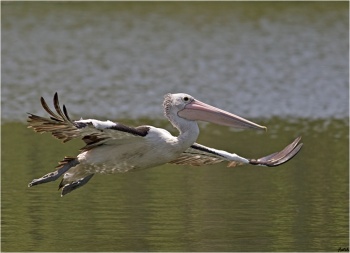(Flight photo) |
(Add External Link) |
||
| Line 24: | Line 24: | ||
{{ref}} | {{ref}} | ||
==External Links== | ==External Links== | ||
| + | *[http://www.arthurgrosset.com/ozbirds/australianpelican.html Arthur Grosset's Birds] | ||
{{GSearch|Pelecanus+conspicillatus}} | {{GSearch|Pelecanus+conspicillatus}} | ||
[[Category:Birds]][[Category:Pelecanus]] | [[Category:Birds]][[Category:Pelecanus]] | ||
Revision as of 16:13, 29 July 2009
- Pelecanus conspicillatus
Identification
1.6 to 1.8 m.
Mainly white with black primaries. Very large pale, pinkish bill.
Distribution
Australia and Tasmania; winters to New Guinea region
Taxonomy
Monotypic[1]
Subspecies P. c. novaezealandiae[2] is not recognised by all authorities.
Habitat
Marine and freshwater environments, lakes and rivers.
Behaviour
Breeding
They nest communally. The nest is a shallow depression in earth or sand, sometimes with some grass lining. Up to three chalky white eggs are laid.
Diet
The diet includes fish.
References
- Clements, JF. 2008. The Clements Checklist of Birds of the World. 6th ed., with updates to December 2008. Ithaca: Cornell Univ. Press. ISBN 978-0801445019.
- Avibase
- Wikipedia
- BF Member observations
Recommended Citation
- BirdForum Opus contributors. (2024) Australian Pelican. In: BirdForum, the forum for wild birds and birding. Retrieved 4 June 2024 from https://www.birdforum.net/opus/Australian_Pelican





